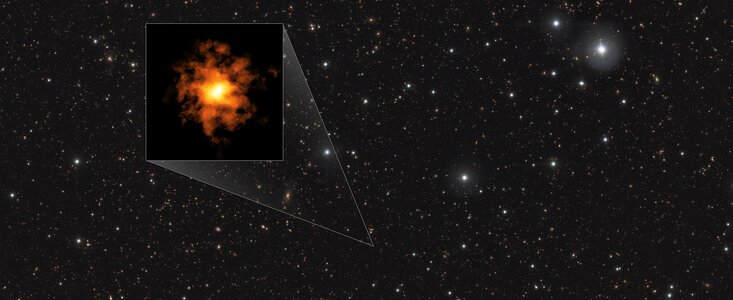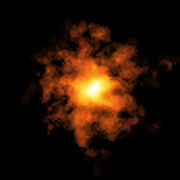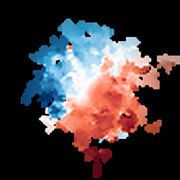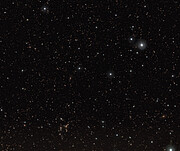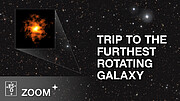Comunicato Stampa
Stranezza spaziale: trovata la più distante galassia con un disco in rotazione
07 Ottobre 2024
Alcuni ricercatori hanno scoperto la più distante galassia simile alla Via Lattea mai osservata. Chiamata REBELS-25, questa galassia a disco sembra ordinata come le galassie odierne, ma noi la vediamo com'era quando l'Universo aveva solo 700 milioni di anni. Ciò è sorprendente poiché, secondo la nostra attuale comprensione della formazione delle galassie, ci si aspetta che le galassie primordiali appaiano più caotiche. La rotazione e la struttura di REBELS-25 sono state rivelate utilizzando ALMA (Atacama Large Millimeter/submillimeter Array), di cui l'ESO (European Southern Observatory) è un partner.
Le galassie che vediamo oggi hanno fatto molta strada rispetto alle controparti caotiche e grumose che gli astronomi osservano tipicamente nell'Universo primordiale. "Secondo la nostra comprensione della formazione delle galassie, ci aspettiamo che la maggior parte delle galassie primordiali siano piccole e dall'aspetto disordinato", afferma Jacqueline Hodge, astronoma presso l'Università di Leida, nei Paesi Bassi, e coautrice dello studio.
Queste disordinate galassie primordiali si fondono tra loro e poi evolvono verso forme più uniformi a un ritmo incredibilmente lento. Le attuali teorie suggeriscono che, affinché una galassia sia ordinata come la Via Lattea, un disco in rotazione con strutture ben identificate come i bracci a spirale, devono essere trascorsi miliardi di anni di evoluzione. L'osservazione di REBELS-25, invece, mette in discussione questa scala temporale.
Nello studio, accettato per la pubblicazione su Monthly Notices of the Royal Astronomical Society, gli astronomi hanno scoperto che REBELS-25 è la più distante galassia con un disco in veloce rotazione mai scoperta. La luce che ci raggiunge da questa galassia è stata emessa quando l'Universo aveva solo 700 milioni di anni, appena il cinque per cento della sua età attuale (13,8 miliardi), rendendo inaspettata la rotazione ordinata di REBELS-25. "Vedere una galassia con tali somiglianze con la Via Lattea, fortemente dominata dalla rotazione, sfida la nostra comprensione di quanto velocemente le galassie nell'Universo primordiale si evolvano nelle galassie ordinate del cosmo odierno", afferma Lucie Rowland, studentessa di dottorato presso l'Università di Leida e prima autrice dello studio.
REBELS-25 è stata inizialmente rivelata durante precedenti osservazioni dello stesso gruppo di lavoro, sempre condotte con ALMA, che si trova nel deserto di Atacama in Cile. All'epoca, si è rivelata una scoperta entusiasmante, poichè la galassia mostrava accenni di rotazione, ma la risoluzione dei dati non era abbastanza fine per esserne certi. Per discernere correttamente la struttura e il movimento della galassia, il gruppo ha eseguito osservazioni successive con ALMA a una risoluzione più elevata, che hanno unque confermato la sua natura eccezionale. "ALMA è l'unico telescopio esistente con la sensibilità e la risoluzione per raggiungere questo obiettivo", afferma Renske Smit, ricercatrice presso la Liverpool John Moores University nel Regno Unito e coautrice dello studio.
Sorprendentemente, i dati hanno anche suggerito caratteristiche più sviluppate simili a quelle della Via Lattea, come una barra centrale allungata e persino bracci a spirale, anche se saranno necessarie altre osservazioni per confermarlo. "Trovare ulteriori prove di strutture più evolute sarebbe una scoperta entusiasmante, poiché sarebbe la più distante galassia fino ad oggi per cui tali strutture sono osservate", conclude Rowland.
Le future osservazioni di REBELS-25, insieme ad altre scoperte di galassie primitive con rotazione, poitrebbero trasformare la nostra comprensione della formazione delle galassie primitive e dell'evoluzione dell'Universo nel suo complesso.
Ulteriori Informazioni
Questo lavoro è stato presentato nell'articolo intitolato “REBELS-25: Discovery of a dynamically cold disc galaxy at z=7.31” pubblicato su Monthly Notices of the Royal Astronomical Society.
Le osservazioni sono state condotte nell'ambito del Large Program di ALMA REBELS: Reionization Era Bright Emission Lines Survey (cioè Survey delle righe di emissione brillanti all'epoca della re-ionizzazione).
L'equipe è composta da L. E. Rowland (Leiden Observatory, Leiden University, Paesi Bassi [Leiden]), J. Hodge (Leiden), R. Bouwens (Leiden), P. M. Piña (Leiden), A. Hygate (Leiden), H. Algera (Astrophysical Science Center, Hiroshima University, Giappone [HASC]; National Astronomical Observatory of Japan, Giappone), M. Aravena (Núcleo de Astronomía, Facultad de Ingeniería y Ciencias, Universidad Diego Portales, Cile), R. Bowler (Jodrell Bank Centre for Astrophysics, University of Manchester, Regno Unito), E. da Cunha (International Centre for Radio Astronomy Research, University of Western Australia, Australia; ARC Centre of Excellence for All Sky Astrophysics in 3 Dimensions), P. Dayal (Kapteyn Astronomical Institute, University of Groningen, Paesi Bassi), A. Ferrara (Scuola Normale Superiore, Italia [SNS]), T. Herard-Demanche (Leiden), H. Inami (HASC), I. van Leeuwen (Leiden), I. de Looze (Sterrenkundig Observatorium, Ghent University, Belgio), P. Oesch (Department of Astronomy, University of Geneva, Svizzera; Cosmic Dawn Center, Danimarca), A. Pallottini (SNS), S. Phillips (Astrophysics Research Institute, Liverpool John Moores University, Regno Unito [LJMU]), M. Rybak (Faculty of Electrical Engineering, Delft University of Technology, Paesi Bassi; Leiden; Netherlands Institute for Space Research, Paesi Bassi), S. Schouws (Leiden), R. Smit (LJMU), L. Sommovigo (Center for Computational Astrophysics, Flatiron Institute, USA), M. Stefanon (Departament d’Astronomia i Astrofísica, Universitat de València, Spagna; Grupo de Astrofísica Extragaláctica y Cosmología, Universitat de València, Spagna), P. van der Werf (Leiden).
ALMA, l'Atacama Large Millimeter/submillimeter Array, un osservatorio astronomico internazionale, è una collaborazione fra l'ESO, la U.S. National Science Foundation (NSF) e gli Istituti Nazionali di Scienze Naturali del Giappone (NINS), in cooperazione con la repubblica del Cile. ALMA è stato fondato dall'ESO per conto dei suoi stati membri, dall'NSF in cooperazione con il National Research Council del Canada (NRC) e dal National Science and Technology Council (NSTC) in Taiwan e dal NINS in cooperazione con l'Accademia Sinica di Taiwan (AS) e l'Istituto di Astronomia e Scienze Spaziali della Corea (KASI). La costruzione e la gestione di ALMA sono condotte dall'ESO per conto dei suoi stati membri, dall'Osservatorio Nazionale di Radio Astronomia (NRAO) gestito dalle Associated Universities, Inc. (AUI) per conto del Nord America e dall'Osservatorio Astronomico Nazionale del Giappone (NAOJ) per conto dell'Asia Orientale. L'osservatorio congiunto di ALMA (JAO: Joint ALMA Observatory) fornisce la guida unitaria e la gestione della costruzione, del commissioning e delle operazioni di ALMA.
L'ESO (European Southern Observatory o Osservatorio Europeo Australe) consente agli scienziati di tutto il mondo di scoprire i segreti dell'Universo a beneficio di tutti. Progettiamo, costruiamo e gestiamo da terra osservatori di livello mondiale - che gli astronomi utilizzano per affrontare temi interessanti e diffondere il fascino dell'astronomia - e promuoviamo la collaborazione internazionale per l'astronomia. Fondato come organizzazione intergovernativa nel 1962, oggi l'ESO è sostenuto da 16 Stati membri (Austria, Belgio, Danimarca, Francia, Finlandia, Germania, Irlanda, Italia, Paesi Bassi, Polonia, Portogallo, Regno Unito, Repubblica Ceca, Spagna, Svezia e Svizzera), insieme con il paese che ospita l'ESO, il Cile, e l'Australia come partner strategico. Il quartier generale dell'ESO e il Planetario e Centro Visite Supernova dell'ESO si trovano vicino a Monaco, in Germania, mentre il deserto cileno di Atacama, un luogo meraviglioso con condizioni uniche per osservare il cielo, ospita i nostri telescopi. L'ESO gestisce tre siti osservativi: La Silla, Paranal e Chajnantor. Sul Paranal, l’ESO gestisce il VLT (Very Large Telescope) e il VLTI (Very Large Telescope Interferometer), così come telescopi per survey come VISTA. Sempre a Paranal l'ESO ospiterà e gestirà la schiera meridionale di telescopi di CTA, il Cherenkov Telescope Array Sud, il più grande e sensibile osservatorio di raggi gamma del mondo. Insieme con partner internazionali, l’ESO gestisce APEX e ALMA a Chajnantor, due strutture che osservano il cielo nella banda millimetrica e submillimetrica. A Cerro Armazones, vicino a Paranal, stiamo costruendo "il più grande occhio del mondo rivolto al cielo" - l'ELT (Extremely Large Telescope, che significa Telescopio Estremamente Grande) dell'ESO. Dai nostri uffici di Santiago, in Cile, sosteniamo le operazioni nel paese e collaboriamo con i nostri partner e la società cileni.
La traduzione dall'inglese dei comunicati stampa dell'ESO è un servizio dalla Rete di Divulgazione Scientifica dell'ESO (ESON: ESO Science Outreach Network) composta da ricercatori e divulgatori scientifici da tutti gli Stati Membri dell'ESO e altri paesi. Il nodo italiano della rete ESON è gestito da Anna Wolter.
Links
- Articolo scientifico
- Fotografie di ALMA
- Per i giornalisti: iscrivetevi per ricevere i nostri comunicati sotto embargo nella vostra lingua
- Per i ricercatori: avete una storia da raccontare? Inviateci il vostro articolo scientifico
Contatti
Lucie Rowland
Leiden Observatory, University of Leiden
Leiden, The Netherlands
Tel.: +31 71 527 2727
E-mail: lrowland@strw.leidenuniv.nl
Jacqueline Hodge
Leiden Observatory, University of Leiden
Leiden, The Netherlands
Tel.: +31 71 527 8450
E-mail: hodge@strw.leidenuniv.nl
Renske Smit
Astrophysics Research Institute, Liverpool John Moores University
Liverpool, UK
Tel.: +44-151-231-2922
E-mail: R.Smit@ljmu.ac.uk
Bárbara Ferreira
ESO Media Manager
Garching bei München, Germany
Tel.: +49 89 3200 6670
Cell.: +49 151 241 664 00
E-mail: press@eso.org
Anna Wolter (press contact Italia)
Rete di divulgazione scientifica dell'ESO
e INAF-Osservatorio Astronomico di Brera
Milano, Italy
Tel.: +39 02 72320321
E-mail: eson-italy@eso.org
Sul Comunicato Stampa
| Comunicato Stampa N": | eso2415it |
| Nome: | REBELS-25 |
| Tipo: | Early Universe : Galaxy |
| Facility: | Atacama Large Millimeter/submillimeter Array |
| Science data: | 2024MNRAS.535.2068R |
Our use of Cookies
We use cookies that are essential for accessing our websites and using our services. We also use cookies to analyse, measure and improve our websites’ performance, to enable content sharing via social media and to display media content hosted on third-party platforms.
ESO Cookies Policy
The European Organisation for Astronomical Research in the Southern Hemisphere (ESO) is the pre-eminent intergovernmental science and technology organisation in astronomy. It carries out an ambitious programme focused on the design, construction and operation of powerful ground-based observing facilities for astronomy.
This Cookies Policy is intended to provide clarity by outlining the cookies used on the ESO public websites, their functions, the options you have for controlling them, and the ways you can contact us for additional details.
What are cookies?
Cookies are small pieces of data stored on your device by websites you visit. They serve various purposes, such as remembering login credentials and preferences and enhance your browsing experience.
Categories of cookies we use
Essential cookies (always active): These cookies are strictly necessary for the proper functioning of our website. Without these cookies, the website cannot operate correctly, and certain services, such as logging in or accessing secure areas, may not be available; because they are essential for the website’s operation, they cannot be disabled.
Functional Cookies: These cookies enhance your browsing experience by enabling additional features and personalization, such as remembering your preferences and settings. While not strictly necessary for the website to function, they improve usability and convenience; these cookies are only placed if you provide your consent.
Analytics cookies: These cookies collect information about how visitors interact with our website, such as which pages are visited most often and how users navigate the site. This data helps us improve website performance, optimize content, and enhance the user experience; these cookies are only placed if you provide your consent. We use the following analytics cookies.
Matomo Cookies:
This website uses Matomo (formerly Piwik), an open source software which enables the statistical analysis of website visits. Matomo uses cookies (text files) which are saved on your computer and which allow us to analyze how you use our website. The website user information generated by the cookies will only be saved on the servers of our IT Department. We use this information to analyze www.eso.org visits and to prepare reports on website activities. These data will not be disclosed to third parties.
On behalf of ESO, Matomo will use this information for the purpose of evaluating your use of the website, compiling reports on website activity and providing other services relating to website activity and internet usage.
Matomo cookies settings:
Additional Third-party cookies on ESO websites: some of our pages display content from external providers, e.g. YouTube.
Such third-party services are outside of ESO control and may, at any time, change their terms of service, use of cookies, etc.
YouTube: Some videos on the ESO website are embedded from ESO’s official YouTube channel. We have enabled YouTube’s privacy-enhanced mode, meaning that no cookies are set unless the user actively clicks on the video to play it. Additionally, in this mode, YouTube does not store any personally identifiable cookie data for embedded video playbacks. For more details, please refer to YouTube’s embedding videos information page.
Cookies can also be classified based on the following elements.
Regarding the domain, there are:
- First-party cookies, set by the website you are currently visiting. They are stored by the same domain that you are browsing and are used to enhance your experience on that site;
- Third-party cookies, set by a domain other than the one you are currently visiting.
As for their duration, cookies can be:
- Browser-session cookies, which are deleted when the user closes the browser;
- Stored cookies, which stay on the user's device for a predetermined period of time.
How to manage cookies
Cookie settings: You can modify your cookie choices for the ESO webpages at any time by clicking on the link Cookie settings at the bottom of any page.
In your browser: If you wish to delete cookies or instruct your browser to delete or block cookies by default, please visit the help pages of your browser:
Please be aware that if you delete or decline cookies, certain functionalities of our website may be not be available and your browsing experience may be affected.
You can set most browsers to prevent any cookies being placed on your device, but you may then have to manually adjust some preferences every time you visit a site/page. And some services and functionalities may not work properly at all (e.g. profile logging-in, shop check out).
Updates to the ESO Cookies Policy
The ESO Cookies Policy may be subject to future updates, which will be made available on this page.
Additional information
For any queries related to cookies, please contact: pdprATesoDOTorg.
As ESO public webpages are managed by our Department of Communication, your questions will be dealt with the support of the said Department.
